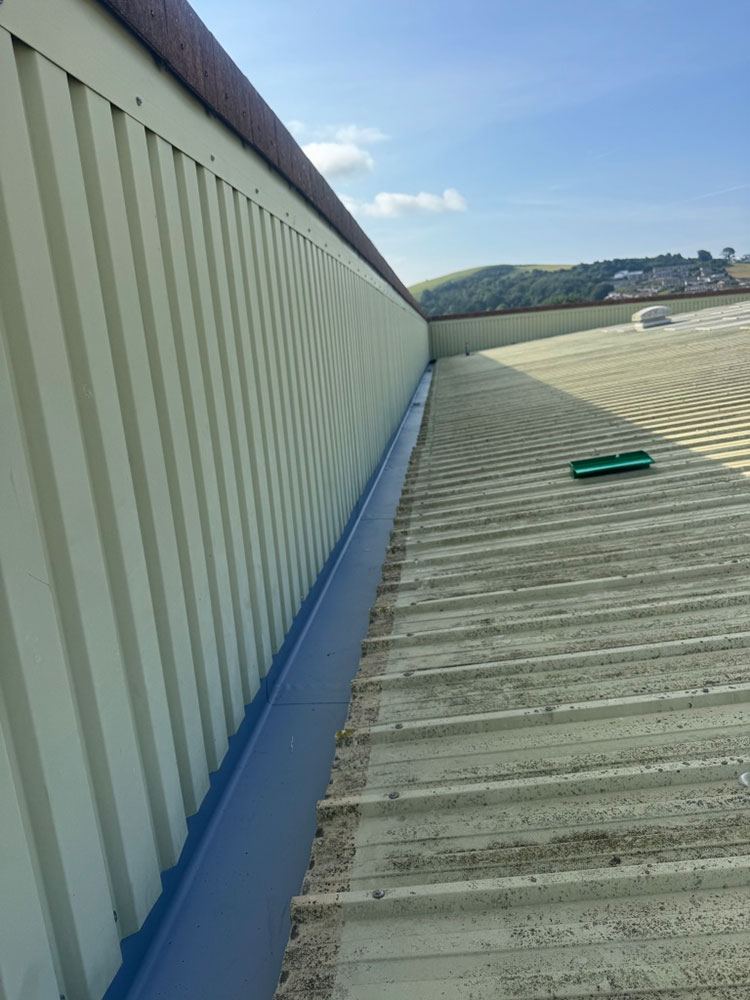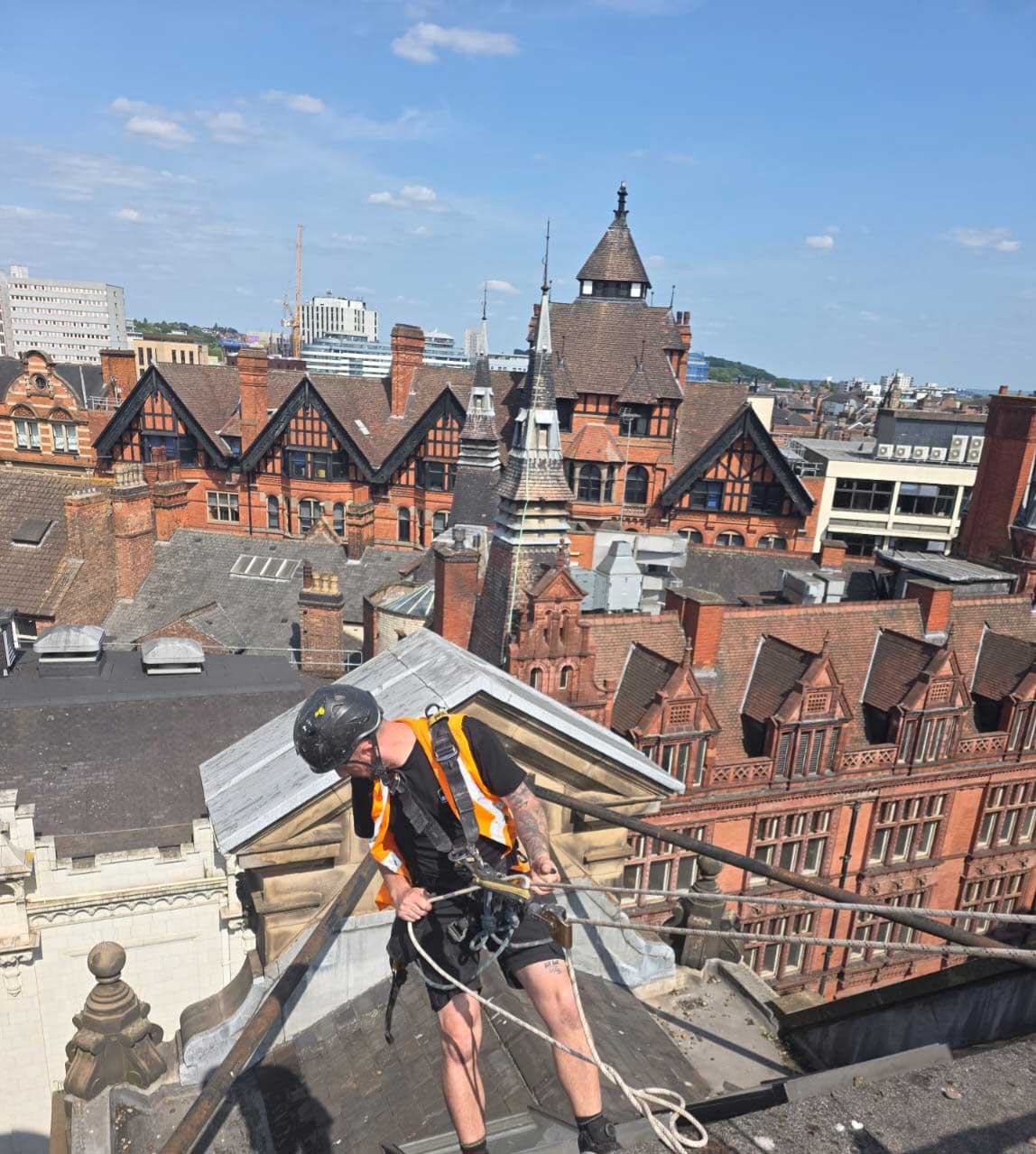
For commercial building owners and facility managers, the roofing system represents one of the most significant capital investments in the entire structure. Understanding the expected service life of different commercial roofing materials is essential for budgeting, maintenance planning, and maximizing return on investment. This comprehensive guide examines the typical lifespans of major commercial roofing systems, factors that influence longevity, and strategies to extend service life regardless of material choice.
Typical Lifespans of Commercial Roofing Systems
Commercial roofing materials vary widely in their expected service lives, initial costs, and maintenance requirements. Here’s a detailed breakdown of common systems and their anticipated performance when properly installed.
Single-Ply Membrane Systems
These flexible sheet materials dominate the commercial roofing market due to their versatility and relative affordability.
TPO (Thermoplastic Polyolefin)
Average Lifespan: 15-25 years
TPO membranes have become increasingly popular for commercial applications due to their:
- Excellent UV and heat resistance
- Energy-efficient white reflective surface
- Hot-air welded seams creating monolithic coverage
- Good chemical resistance
- Cost-effectiveness compared to other single-ply options
TPO’s lifespan depends significantly on membrane thickness:
- 45-mil TPO: 15-18 years expected service life
- 60-mil TPO: 18-22 years expected service life
- 80-mil TPO: 20-25+ years expected service life
Lifecycle Considerations: First-generation TPO systems had issues with premature failure, but modern formulations have addressed many early concerns. Membrane thickness is a key factor in determining longevity, with thicker materials generally providing longer service life.
PVC (Polyvinyl Chloride)
Average Lifespan: 20-30 years
PVC roofing offers several performance advantages:
- Exceptional chemical resistance
- High-temperature tolerance
- Excellent waterproofing reliability
- Strong resistance to biological growth
- Hot-air welded seams with high integrity
Similar to TPO, thickness affects longevity:
- 50-mil PVC: 20-25 years typical performance
- 60-mil PVC: 25-28 years typical performance
- 80-mil PVC: 28-30+ years typical performance
Lifecycle Considerations: PVC has a longer performance track record than TPO, with some installations exceeding 30 years in ideal conditions. It performs particularly well in regions with high UV exposure and around restaurants or industrial facilities with grease or chemical exposure.
EPDM (Ethylene Propylene Diene Monomer)
Average Lifespan: 22-35 years
EPDM “rubber” roofing offers remarkable durability:
- Exceptional weathering characteristics
- Superior ozone and UV resistance
- Excellent low-temperature flexibility
- Simple repair procedures
- Proven long-term performance history
EPDM’s longevity is influenced by:
- Membrane thickness (45-mil vs. 60-mil vs. 90-mil)
- Installation method (ballasted, fully adhered, or mechanically attached)
- Seam technology (tape systems outperform liquid adhesives)
Lifecycle Considerations: EPDM has one of the longest performance track records among single-ply materials, with documented cases of 40+ year service lives in ballasted applications. Its black surface absorbs heat in northern climates but can increase cooling costs in southern regions.
Built-Up Roofing (BUR) Systems
Average Lifespan: 20-30 years
Traditional built-up “tar and gravel” roofs consist of alternating layers of bitumen and reinforcing fabrics:
- Time-tested technology with centuries of performance history
- Exceptional waterproofing redundancy with multiple layers
- Excellent puncture resistance due to layered construction
- Good traffic resistance for rooftops with frequent maintenance access
- Self-healing properties with certain bitumen types
Factors affecting BUR longevity include:
- Number of plies (3-ply vs. 4-ply vs. 5-ply)
- Surfacing type (gravel, coating, cap sheet)
- Bitumen type (asphalt vs. coal tar)
- Reinforcement materials (organic felts vs. fiberglass felts)
Lifecycle Considerations: Though less common in new construction due to installation complexity and odor concerns, BUR systems remain one of the most reliable and longest-lasting commercial roofing options when properly installed and maintained.
Modified Bitumen Systems
Average Lifespan: 20-30 years
Modified bitumen combines traditional BUR technology with polymer modifications:
- SBS (Styrene-Butadiene-Styrene) modified: 20-30 years
- APP (Atactic Polypropylene) modified: 20-25 years
- Hybrid systems: 20-30 years
These systems offer:
- Factory-controlled membrane thickness
- Reinforcement options (polyester, fiberglass, or composite)
- Installation flexibility (torch-applied, cold-applied, hot-mopped, self-adhered)
- Multiple surfacing options (granules, foil, coating)
Lifecycle Considerations: Modified bitumen systems bridge the gap between BUR and single-ply technologies, offering easier installation than traditional BUR while maintaining multi-ply redundancy. Two-ply systems significantly outperform single-ply configurations.
Metal Roofing Systems
Average Lifespan: 30-60 years
Metal roofing offers exceptional longevity when properly designed and installed:
Standing Seam Metal
Average Lifespan: 40-60 years
- Aluminum systems: 40-50 years
- Zinc systems: 60+ years
- Copper systems: 70+ years (with potential for 100+ years)
- Steel systems: 30-45 years (depending on coating quality)
Standing seam systems feature:
- Raised seams above water flow
- Concealed fasteners protected from elements
- Thermal movement accommodation
- Minimal penetrations through weathering surface
Lifecycle Considerations: Metal longevity depends heavily on material thickness (gauge), coating quality, and design details. Systems with proper slope, adequate underlayment, and quality coatings consistently outperform those with marginal specifications.
Metal Shingles and Tiles
Average Lifespan: 30-50 years
- Steel systems: 30-40 years
- Aluminum systems: 40-50 years
- Zinc systems: 50+ years
These systems offer:
- Aesthetic appeal with traditional appearance
- Modular replacement capability
- Often higher wind resistance than panels
- Lower expansion/contraction issues due to smaller individual pieces
Lifecycle Considerations: Metal shingle lifespans depend on material quality, substrate preparation, and installation precision. Systems with quality underlayment significantly outperform those installed directly to substrate.
Spray Polyurethane Foam (SPF) Systems
Average Lifespan: 20-30+ years
SPF roofing combines insulation and waterproofing in a single system:
- Seamless application eliminates joint vulnerabilities
- Self-flashing capability around penetrations
- Excellent insulation properties (R-6.5 per inch)
- Renewable through recoating programs
SPF longevity depends heavily on:
- Foam thickness (1.5″ vs. 2″ vs. 3″)
- Coating type (acrylic vs. silicone vs. polyurea)
- Coating thickness (typically 20-30 mils)
- Maintenance frequency (recoating schedule)
Lifecycle Considerations: SPF systems require regular maintenance coatings, typically every 10-15 years, to achieve their full lifespan potential. When properly maintained, some systems have exceeded 40 years of service.
Vegetative (Green) Roof Systems
Average Lifespan: 40-50+ years
Green roofing technology offers exceptional durability:
- Extensive systems (shallow growing medium): 40-50 years
- Intensive systems (deep growing medium): 50+ years
These systems feature:
- Protection of waterproofing from UV degradation
- Reduced thermal cycling stress
- Temperature moderation benefits
- Environmental and aesthetic advantages
Lifecycle Considerations: While waterproofing components are typically standard materials (often PVC or TPO), their protected environment significantly extends their service life. Electronic leak detection systems are often incorporated to identify issues before damage occurs.
Factors That Influence Commercial Roof Longevity
While material selection establishes the baseline potential lifespan, numerous factors influence whether a roofing system achieves its full service life potential.
Installation Quality
The most significant non-material factor affecting roof longevity is installation quality:
- Manufacturer Certification: Contractors certified by material manufacturers demonstrate 40% longer average system performance compared to non-certified installers.
- Detail Execution: Research indicates that over 90% of premature roof failures occur at transitions, penetrations, and terminations rather than field membrane.
- Weather Conditions During Installation: Materials installed outside manufacturer temperature guidelines show 15-30% shorter service lives.
- Supervision Level: Projects with dedicated quality control personnel experience 35% fewer premature failures.
Design Considerations
Architectural and engineering decisions significantly impact roof performance:
- Slope Adequacy: Roofs with less than manufacturer-recommended slope experience 30-50% shorter lifespans due to ponding water.
- Drainage Design: Systems with positive drainage and overflow provisions last 25-40% longer than those with minimal drainage.
- Penetration Density: Each roof penetration represents a potential failure point; research shows a direct correlation between penetration quantity and leak probability.
- Edge Detail Design: Enhanced perimeter details following FM Global guidelines show 60-80% fewer wind-related failures.
- Traffic Protection: Designated walkways and protection pads extend membrane life in maintenance paths by 300-400%.
Climate and Environmental Exposure
Regional location and specific environmental conditions dramatically affect performance:
- UV Exposure: Identical systems in Arizona versus Minnesota show 20-40% lifespan differences due to solar intensity.
- Temperature Extremes: Roofs experiencing greater thermal cycling demonstrate accelerated aging, with studies showing 5-10% lifespan reduction for each 10°F increase in average daily temperature fluctuation.
- Chemical Exposure: Roofs near industrial facilities experience 15-30% shorter lifespans due to chemical fallout.
- Wind Patterns: Buildings in high-wind zones show 20-35% higher maintenance costs and shorter system lifespans.
- Precipitation Types: Regions with freezing rain and significant snowfall experience accelerated degradation compared to warm rain climates.
Maintenance Practices
Regular maintenance is perhaps the most controllable factor affecting roof longevity:
- Inspection Frequency: Professionally inspected roofs last 30-45% longer than those without regular assessment.
- Debris Removal: Regular cleaning extends roof life by preventing biological growth and drainage blockage.
- Prompt Repairs: Addressing defects within 30 days of discovery prevents 90% of minor issues from becoming major failures.
- Foot Traffic Management: Controlled access and dedicated walkways reduce puncture-related failures by 70-80%.
- Professional Maintenance: Contractor maintenance programs extend roof life by 25-40% compared to in-house maintenance.
Strategies to Maximize Commercial Roof Lifespan
Regardless of material selection, several best practices can help any commercial roofing system achieve or exceed its expected service life.
Proactive Inspection Programs
Implementing a systematic inspection program delivers significant returns:
- Baseline Documentation: Creating a comprehensive roof condition assessment immediately after installation establishes critical reference points.
- Seasonal Inspections: Professional evaluation before and after extreme weather seasons identifies potential issues before failure.
- Digital Documentation: Modern drone and photographic documentation allows precise tracking of developing conditions.
- Infrared Moisture Scanning: Regular thermal imaging identifies subsurface moisture before it manifests as leaks.
- Core Analysis: Periodic material sampling provides objective data about system degradation rates.
Strategic Maintenance Timing
The timing of maintenance activities significantly impacts effectiveness:
- Seasonal Optimization: Scheduling repairs during moderate temperature periods improves material performance and adhesion.
- Pre-Extreme Weather: Conducting inspections and repairs before storm seasons prevents minor issues from becoming catastrophic failures.
- Manufacturer Milestone Maintenance: Implementing specified maintenance at key intervals maintains warranty coverage.
- Coating Renewal Timing: Applying restorative coatings before critical degradation thresholds extends service life significantly.
Restoration vs. Replacement Evaluation
As roofs approach expected service life, restoration often provides exceptional value:
- Coating Systems: Applied to aging single-ply or metal roofs, coatings can add 10-15 years of service life at 30-50% of replacement cost.
- Recover Systems: Installing new roofing over existing (where code permits) can provide new-roof performance at 60-70% of tear-off cost.
- Targeted Replacement: Addressing deteriorated sections while maintaining intact areas optimizes capital expenditure.
- Phased Implementation: Strategically sequencing restoration projects across building sections maximizes budget efficiency.
Warranty Optimization
Maximizing warranty protection enhances roof investment:
- Extended Warranty Options: Many manufacturers offer premium coverage options that include regular inspections and preventative maintenance.
- Workmanship Coverage: Separate installation quality warranties from material warranties provides comprehensive protection.
- Transferable Documentation: Maintaining detailed records ensures warranty continuity during property transfers.
- Compliance Verification: Documenting all manufacturer-required maintenance preserves warranty enforcement rights.
Signs Your Commercial Roof Is Approaching End of Life
Recognizing the indicators of a roof nearing the end of its functional lifespan helps facility managers plan for replacement before catastrophic failure:
Material-Specific End-of-Life Indicators
Single-Ply Membranes
- TPO/PVC Warning Signs:
- Surface crazing or micro-cracking
- Brittleness when flexed
- Visible reinforcement scrim through surface weathering
- Weld failure at seams
- Membrane shrinkage exposing attachment points
- EPDM Warning Signs:
- Surface checking (small cracks)
- Significant shrinkage at perimeters
- Seam adhesive failure
- Brittleness rather than elasticity
- Membrane thinning at exCommercial roofing materials vary widely in their expected service lives, initial costs, and maintenance requirements. Here’s a detailed breakdown of common systems and their anticipated performance when properly installed.posed areas
BUR and Modified Bitumen
- End-of-Life Indicators:
- Alligatoring (severe surface cracking)
- Membrane splitting
- Exposed reinforcement felts
- Granule loss exceeding 50% of surface
- Brittleness of field samples
- Significant blistering or ridging
Metal Roofing
- Replacement Indicators:
- Pervasive rust or corrosion
- Panel perforation
- Coating failure exceeding 30% of surface
- Seam failure allowing water intrusion
- Structural concerns from extended rust damage
Spray Foam Systems
- Restoration/Replacement Signs:
- Coating erosion exposing foam
- UV degradation of exposed foam
- Adhesion failure between foam and substrate
- Significant areas of foam decomposition
- Excessive ponding due to substrate deformation
Universal End-of-Life Indicators
Regardless of roofing type, these signs suggest replacement is imminent:
- Repair Frequency: When repairs are needed more than twice annually in multiple areas
- Leak History: Progressive increase in leak frequency despite repairs
- Membrane Fatigue: Material no longer rebounds or recovers from stress
- Interior Evidence: Persistent moisture intrusion despite maintenance
- Insulation Saturation: More than 25% of roof insulation containing moisture
- Economic Threshold: When annual maintenance costs exceed 3% of replacement value
Sustainable End-of-Life Options
When commercial roofs reach the end of their service life, several environmentally responsible options exist:
Recycling Programs
Material-specific recycling opportunities reduce landfill impact:
- Metal Roofing: Nearly 100% recyclable with established scrap metal markets
- EPDM: Grinding programs for playground surfacing and new membrane production
- TPO/PVC: Emerging recycling programs converting material to walkway pads
- Asphalt-Based Products: Recycling into paving materials and new roofing
Roof Overlay Potential
Where building codes permit, overlaying existing roofing reduces waste:
- Code Limitations: Typically maximum of two roofing systems
- Weight Considerations: Structural engineering assessment required
- Material Compatibility: Most materials can accept appropriate overlays
- Performance Expectations: Properly executed overlays perform similarly to new construction
Selective Replacement
Targeting only deteriorated sections minimizes waste:
- Moisture Mapping: Infrared technology identifies specifically damaged areas
- Phased Implementation: Strategic replacement of worst sections first
- Original Material Matching: Aesthetically compatible integration with existing roof
- Performance Enhancement: Opportunity to improve poorly performing details
Conclusion
The longevity of commercial roofing systems varies dramatically based on material selection, installation quality, environmental exposure, and maintenance practices. While manufacturers provide expected service life estimates, actual performance depends on numerous controllable factors that building owners and facility managers can influence.
By understanding the typical lifespans of different roofing materials, recognizing the factors that affect longevity, and implementing best practices for maintenance and management, commercial property stewards can maximize their roofing investment while ensuring continuous protection of the valuable assets beneath.
The most cost-effective approach to commercial roofing incorporates strategic planning throughout the entire lifecycle—from initial material selection through regular maintenance to end-of-life decisions. With proper care and attention, many commercial roofing systems can significantly exceed their nominal expected service lives, delivering exceptional return on investment while protecting building operations.









